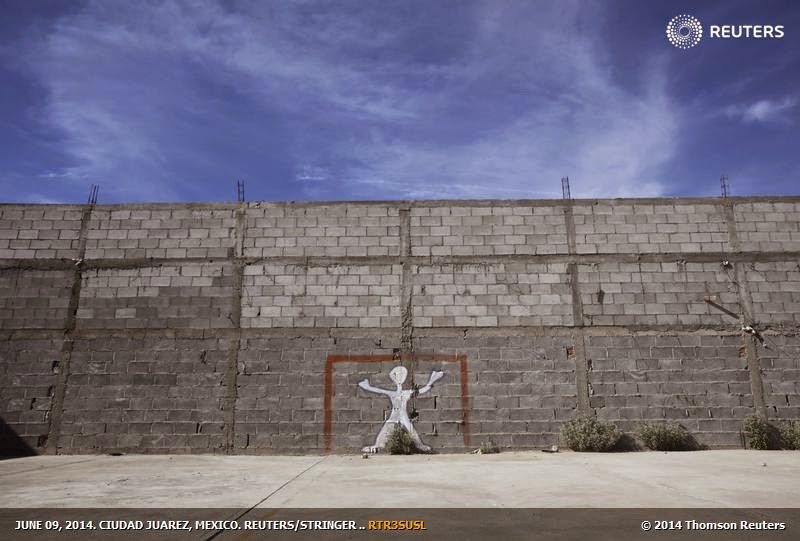Sometimes the best ideas are also the simplest ones, especially when you have the support of the world’s biggest news agency behind you.
Children play soccer on a playing field in Kirtipur, Kathmandu May 31, 2014. The 2014 Brazil World Cup opens on June 12 and fans around the globe are gearing up for the big tournament. REUTERS/Navesh Chitrakar
Inspired by the energy generated by a Wider Image workshop with our photographers in South America, I wanted to work on a global story about the Brazil 2014 World Cup. So many superlatives are used to describe it: the world’s greatest show, the most watched tournament, the biggest sporting event.
A goalpost is painted on a wall at a house used as a creche in Ciudad Juarez June 3, 2014. The 2014 Brazil World Cup opens on June 12 and fans around the globe are gearing up for the big tournament. But soccer lovers are not only preparing to watch the world's best professional players battle it out on the pitch; they are also out there kicking a ball about themselves. REUTERS/Jose Luis Gonzalez
I needed a big idea that could demonstrate the worldwide reach of football (or soccer, for our U.S readers) and I wanted to include our global team of busy photographers. For them to find the time to get involved, the idea had to be simple.
I once heard that the rules of football are among the most universally recognised codes in the world. They transcend divides of creed, culture, education, geography and wealth. Off-side is off-side no matter who you are, or what your nationality. And what is football actually about? It’s about goals.
And what is a goal? That moment of ecstatic joy, crushing defeat, a game won, lost or drawn (unless it’s a dull 0-0). Lucky, unlucky, frequently contentious, always an event. Maybe it should have been a goal and was disallowed, maybe it shouldn’t have been but was counted anyway. Goals can signify millions of dollars won or lost or invested in the business of football. They can mean winning or losing a bet.
A makeshift soccer goalpost stands near Molweni, west of Durban June 5, 2014. The 2014 Brazil World Cup opens on June 12 and fans around the globe are gearing up for the big tournament. But soccer lovers are not only preparing to watch the world's best professional players battle it out on the pitch; they are also out there kicking a ball about themselves. Reuters photographers on every continent, in countries from China to the Czech Republic, went out to capture images of soccer goalposts used by players to practise the 'beautiful game'. REUTERS/Rogan Ward
And what is an actual physical goal? FIFA’s rules are strict, but simple: “The distance between the posts is 7.32 m (8 yds) and the distance from the lower edge of the crossbar to the ground is 2.44 m (8 ft)… Both goalposts and the crossbar have the same width and depth, which do not exceed 12 cm (5 ins).”
I read this, and an idea came to me. Imagine the world viewed through the single constant of a goalpost: the green grass and cloudy skies of Manchester, the dusk in Karachi, a cityscape in Boston, Kathmandu and Tokyo. I checked with a colleague to see that this was not a daft idea. He loved it.
I knew that to get what I was looking for I needed to apply some structure. Experience has told me that photographers, on the whole rightly so, tend to follow their own ideas better than they follow those of others (no disrespect team, but it is as it is).
I set some guidelines: a 24mm lens should be used, the pictures should be shot from the distance of the penalty spot (FIFA rules) and the camera should be at a height of 2 ft, from behind or in front, whatever looked better. My “goal” was to ensure that the position of the goalposts in the picture frame was a constant. I even shot a picture myself to explain what I wanted. What guide could be simpler to stick to?
Some followed the instructions to the letter, a few ignored some of them, and an elite handful completely made up their own rules. I love the result! I hope you do too. Click here to see the pictures


.jpg)

No comments:
Post a Comment